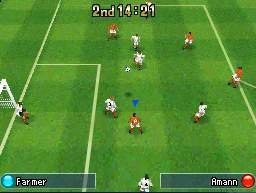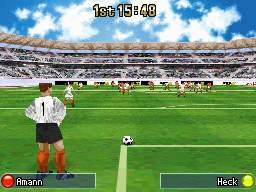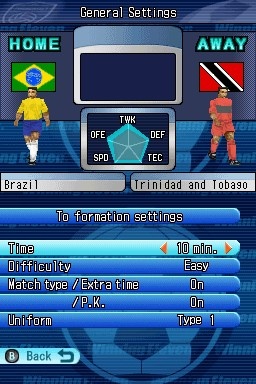While Pro Evolution Soccer is generally known for its realism and attention to detail on the pitch, Konami's first foray for this franchise into the Nintendo DS market has different priorities. These priorities include the need to create a game that not only works within the technical limitations of the DS but also takes advantage of the platform's unique features. The result is a game that's generally uncomplicated to play: While veterans of the series might find it basic, it's accessible and fun.

You can choose to play an exhibition match as and against any of 57 national teams, the 10 licensed club teams, or Konami's age-old original team. On top of those options, there's a world tour mode, which forms the backbone of the single-player game, a simple cup competition, and some multiplayer modes. There are licensed players on a few of the teams, and assuming you can actually work out who the players are supposed to be, it is possible to edit names and a handful of statistics.
The world tour mode assigns you the challenge of beating every national team in the game and sets you up with Konami's original team, which consists of the franchise's now-classic made-up players, including Ivarov, Ceciu, and Huylens. The opposition teams are split up into 10 groups, ranked in order of quality, and you unlock the next group once you've beaten the first, and so on.
Each time you defeat a team, you're rewarded with some silver coins, and throughout the tour, you'll win a handful of gold coins as you hit various milestones. These can be spent in the "gacha get," a virtual version of the toy dispenser commonly found in Japan. You drag a coin into the slot, turn a lever, and an egg containing a player drops out. The player that drops out is randomly chosen from any of the teams you've beaten so far, and gold coins are more likely to yield a star player than silver ones. Then, you have the opportunity to integrate the new player into your team, and in that way, you're able to gradually improve your squad over time.
The options for each match are pretty basic and are limited to the kit colours (combinations of home or away) and the game level (easy, normal, or difficult). There are no weather effects or time-of-day options, and all games take place at a single generic stadium. From there you're taken to the formation settings screen, where you can choose from a handful of popular options or micromanage the positions and mentalities of each player on the pitch, as well as select the set-piece takers. There's also an "autosort" button that will automatically select the best players from your squad to fit your formation, which is based on quality and form. Your team's formation settings can have an impact on the way the game plays out, although in reality, the effects are limited. For example, if you choose to play three in attack, you will find that on occasion you'll be overwhelmed in other areas. But if you have only a single striker up front, you could find penetrating the opponent's defense slightly more difficult.
However, those examples are very general. Even if you extensively tweak all of the other options, it seems to bear little fruit because most of the time the matches play out in remarkably similar ways. This is mainly down to the limited controls available on the DS, which yield a limited number of options for effectively playing the ball.

Movement is controlled with the D pad, while the left shoulder button cycles through player selection and the right shoulder button makes the player sprint. The remaining face buttons take care of the passing, tackling, and shooting options, while there are a couple of combinations that yield a fake shot or lofted through ball.
The touch screen isn't used to control players, although you can switch between attacking and defensive stances with it. You can also use it to display either your team's formation, with information on each player's energy levels, or a large version of the minimap, which on the top screen is so small that it's almost useless.
In theory, the controls fulfill all of the moves you'd expect to be able to execute, but in practice, it's quickly evident that there's little by way of finesse in the system. Sometimes the buttons don't respond as quickly as you'd like, and directional accuracy can be difficult on the small D pad. To compensate for those limitations, Konami has had to make some concessions within the game to make it playable, and these concessions make the game feel simplistic.
For example, if you come too close to an opposition player, you're almost certain to lose the ball. But at times, the artificial intelligence controlling those players has an alarming tendency to leave big gaps between the players through which you can run. There are also some gameplay quirks that pop up with some regularity. The through ball pass is incredibly inconsistent, at times playing the ball in front of your intended target, but often selecting a player on the other side of the pitch instead, who is neither closer nor has a remote chance of getting the ball before it's intercepted.
On top of that, the ball never stops once it's passed, so you'll find the ball going out of play a lot, even though the pass itself should have been short and simple. And if you do get the ball to a striker, almost any shot, from any player, will beat the keeper if it's hit from inside the box. Even long shots, providing they're on target, have a great chance of hitting the back of the net, and netting upward of six or seven goals in a five-minute game is easily possible.
These idiosyncrasies can become frustrating in the long term, but if you take the game in shorter bursts, something the platform is designed to do, you won't notice them as much. Getting through the world tour and its bonus group at the end can take upward of six hours, and with the cup, training, and exhibition options, there's plenty of action to enjoy in the single-player modes.
But there are also some nice multiplayer options in the game, including local wireless matches, the ability to take on gamers across Nintendo's Wi-Fi network. In particular, this last option, which requires access to a wireless Internet connection, adds a lot to the game in terms of appeal because playing against human opposition is more entertaining than the stilted AI teams.
In practice, these online games are easy to set up and run smoothly. There is a touch of slowdown on occasion, but nothing that really affects gameplay. It's also impossible for anybody to cheat by disconnecting from the match, as even if you shut the DS, the game continues without you. This helps you keep an honest track of your performance online, as your results tally is recorded on your game card, and you can search specifically for matches against players of a similar level.

Visually, the game is no graphical powerhouse, but there's nothing offensive about it, and certainly the graphics don't get in the way of enjoying the game. There is a bit of an issue with slowdown when there are too many players onscreen, which happens virtually every time there's a corner kick, but again, it's not a major problem.
The sound effects in the game are also pretty basic, with crowd sounds that rise and fall depending on where the ball is in play. The sample lengths, especially at the more excited end of the scale, are pretty short, and the result is an irritating noise that repeats over and over. On a lighter note, when a goal is scored, you're treated to a scratchy piece of commentary, which sounds remarkably like an announcer from the 1966 World Cup final. Somehow we're not sure that was intentional. Aside from that, there's very little in the way of sound effects, although there are a few nice, pumping music tracks to accompany the different setup screens.
Overall, the Nintendo DS version of Pro Evolution Soccer 2007 isn't likely to be the kind of game that will appeal to dedicated soccer gamers, but newcomers shouldn't have too much trouble coming to grips with it. It won't hook you for a long time, but it does offer a portable, entertaining soccer game. And while there's enough single-player content to get through in a modest amount of time, there's a lot more enjoyment to be had if you've got access to a wireless Internet connection.